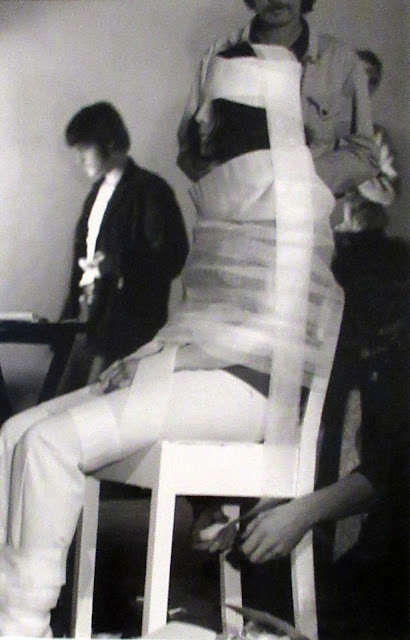Yoko Ono - Music of the Mind
at Tate Modern.
This is the second post on this exhibition. If you would like to see the first post go here . As I would like to stand each post on its own, I have included the introduction from the first post, so, if you have read that already, scroll down to: The Message is the Medium.
I am a great fan of Ono's work so it was a real pleasure seeing this exhibition, which by the way, was on quite a while ago.
Music of the Mind celebrates the work of artist and activist Yoko Ono. The exhibition explores Ono's conceptual practice, foregrounding ideas over objects, alongside her ongoing campaign for world peace. It takes its title from the artist's desire to stimulate the imagination. Ono notes: 'The only sound that exists to me is the sound of the mind. My works are only to induce music of the mind in people... In the mind-world, things spread out and go beyond time'.
The exhibition traces Ono's radical approach to art, language and participation, from her early 'instruction' pieces to her recent, large-scale installations. It covers seven decades of her expansive practice from 1955 to today. During this time, Ono moved between Japan, the US and the UK, before settling in New York in 1971.
Following a loose chronology, the exhibition highlights recurring ideas and themes in Ono's work, making connections across time and place.
Ono's art takes many forms. It includes scores, performances, objects, film, music, sound and events. In 1964, Ono published Grapefruit, her foundational book of instruction works. These concise texts, somewhere between poem and score, aim to unlock the mind. Instructions are presented throughout the exhibition, calling you to participate, often with others.
Ono invites one to realise her artworks - to construct paintings in the mind, perform inside a bag, play a game of chess and share memories and wishes. But, most importantly, she invites us to imagine. This collective call to action is a provocation to change the world, one wish at a time.
A dream alone is only a dream.
A dream you dream together is reality.
Yoko Ono.
It's been very difficult getting these posts together, given the nature of Ono's art, its conceptual nature which is very cerebral, but I hope I have done it justice.
The Message is the Medium:
Ono stayed in England for five years, between 1966 and 1971. During her stay she connected with artists, musicians and writers, including John Lennon, her future husband and long-term artistic partner.
In the context of the US civil rights movement, second-wave feminism and growing opposition to the American War in Vietnam, Ono's campaigning work gained mainstream interest. Working in collaboration with Lennon, Ono used her art and global media platform to advocate for humanitarian causes and world peace. In the late 1960s, they wrote to world leaders, created billboard campaigns, recorded songs and staged Bed-in events. Their message of nonviolence resounded in their song 'Give Peace a Chance', which became an anthem of the international peace movement.
Painting to Hammer a Nail, concept 1961, first realised 1966, (painted wood panel, nails, chain, painted hammer)
Hammer a nail into a mirror, a piece of glass, a canvas, wood or metal every morning. Also, pick up a hair that came off when you combed in the morning and tie it around the hammered nail. The painting ends when the surface is covered with nails.
Poster for Unfinished Paintings and Objects
In the exhibition Unfinished Paintings and Objects each work required completion by the viewer, either in their imagination or as a physical participant.
Yoko Ono preparing the piece for Unfinished Paintings and Objects at Indica Gallery, London, 9-22 November 1966.
Wrapping Piece,1961, photographed 26 September 1967
These photographs show Ono in Liverpool, performing works that encouraged audience participation. During Wrapping Piece, Ono invited viewers onstage and asked them to wrap her in gauze until she disappeared. The performance was part of a series of concerts called Music for the Mind that Ono put on in Liverpool and London.
Yoko Ono, John Lennon, Bed Peace, 1969

Following their marriage in March 1969, Ono and Lennon hosted week-long Bed-in For Peace campaigns in Amsterdam and Montreal. The couple created a media frenzy by inviting peace campaigners and activists to join them in their hotel rooms. While in bed in a hotel in Montreal, joined by Timothy Leary, Petula Clarke, Dick Gregory and Alan Ginsberg, they recorded the track Give Peace A Chance. It was quickly adopted by those protesting the American War in Vietnam. Ono explained, 'we're using our money to advedrtise our ideas so that peace has equal power with the meanies who spend their money to promote war'.
Yoko Ono, John Lennon, WAR IS OVER! If you want it, 1969
Ono and Lennon used their public platform to promote peace. They co-opted the techniques of advertising and political propaganda, using mass media to quickly spread and amplify their message. They created artworks such as WAR IS OVER. If you want it, which was distributed in 12 cities around the world through billboards, posters, posters and radio and newspaper adverts.
This was not mentioned at the exhibition, but I understand that this is how Ono and Lennon met. He went to an exhibition and for one of the pieces you had to climb a ladder and with the magnifying glass look at a painting that was positioned inside a trap door. Lennon climbed up, looked at the painting and then said: 'What an amazing artist. I would like to meet them'. And the rest is history....
White Chess Set, 1966, (white chess sets, tables, chairs)


















No comments:
Post a Comment